 Tell us a little about your background.
Tell us a little about your background.
I was born in the US and was about to begin first grade when my family moved to Germany a few years following WW II. Under the Marshall Plan (The European Recovery Program), military families were being sent overseas and an American School System was being established. My dad, not in the military, went over as a high school teacher and rose through the ranks of the American Dependent School System. I was, at various points, the Principal’s daughter and the Superintendent of Schools’ daughter and, after I graduated high school, he was Director of Curriculum.
I am forever grateful that my parents chose this life as it turned out to be an incredible opportunity for my brother and I to travel and experience so much. My brother, in fact, went into the State Department after University and continued the lifestyle of living all around the world. After I graduated from high school (we were now in Italy), I thought it insane to return to the US to attend art school when I was living in a country known for its art treasures. I enrolled at the L’Accademia di Belle Arti di Brera in Milan to study fine art (painting), graduating four years later after nailing my exams in Italian.
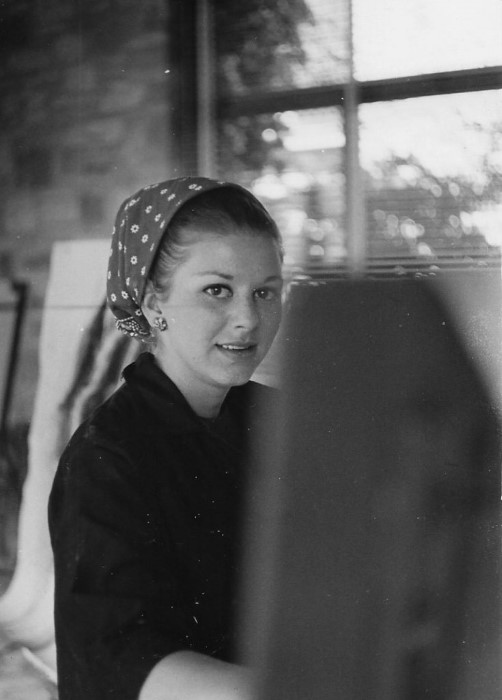
Being a young adult in Italy was a gift. It was a time when Italian films and directors like Fellini were all the rage. Great opera took place not only at La Scala in Milan, but also in Verona‘s ancient arena every summer. Milan was the fashion capital of Italy and I was keenly aware the “style” and attitudes of the very chic Italians.
In 1965, I moved to New York City to start a career. My dream was a position at Harper’s Bazaar or Vogue magazine. Unfortunately, I couldn’t type fast enough. Yes, that’s right. I couldn’t type fast enough. I was well travelled, spoke three languages, and possessed a fine portfolio; however, these attributes were not what qualified a young woman to start a career in those days. Women were pretty limited to jobs as secretaries, nurses, or teachers.
As fate would have it, I stumbled into the perfect job and was hired instantly. I became a staff fashion stylist for one of the most celebrated advertising agencies in the world, DDB (Doyle, Dane, Bernbach, Inc.). My sense of color and style, along with my artistic abilities, served me very well. I worked with some of advertising’s trailblazers as well as the most sought-after models, photographers, and directors of the time. I travelled to cover photo and TV shoots in California, Florida, Jamaica, and Europe. It was by far the most exciting time in advertising.
After a number of years, I became bored and yearned to be one of the “creatives.” Encouraged by a female creative supervisor, I decided to become an art director even though there were only two women art directors in the entire agency of 1,200 employees.

I succeeded because I was intensely interested in the collaborative process of creating print ads and television commercials. I was great at coming up with concepts and I learned about editing (film and print), from hanging out with the art directors, TV producers, and film editors during the post-production process. I went to the School of Visual Arts at night to develop my portfolio, which I took to the creative director a year later. When I got the green light, I gave up my office, took a pay cut, and moved to the art studio Bullpen “with the guys” to learn how to do paste-ups and mechanicals. I did this joyfully and three months later started work as an assistant art director and over time became an art supervisor. I had succeeded in making an unprecedented move and changing my career within the agency.
I was at DDB for a total of 16 years. I credit my experiences there with teaching me how to entice the attention and interest of consumers, create budgets, and produce print shoots. I became great at casting and hiring exceptional photographers, hair, and makeup talent. I found I was great at writing and worked directly with one of our clients on an area where I really excelled: new product development. Most of all, I enjoyed the teamwork required to make great advertising.
Being flexible, and in a state of continual learning, as well as challenging myself to “go for it,” followed me for decades into my current path. Yet it feels like a lifetime in between my beginnings in advertising and where I am today.
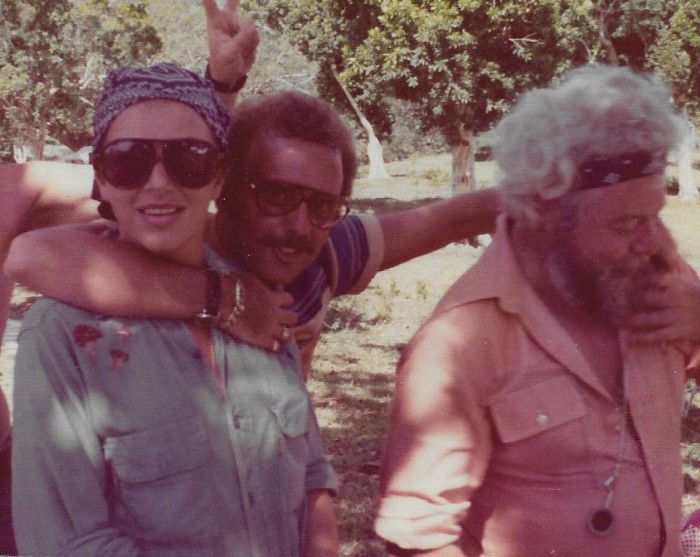
On location in Jamaica for a TV shoot
When did you start to think about making a change in midlife?
All personal dreams I had were shoved to the backburner by what came next. I had moved on from DDB in 1981 and was freelancing and pursing other interests. In 1984, my mother’s health began declining rapidly. My father had died suddenly a few years prior and my brother lived with his family in Japan. So my involvement with my mother’s care steadily increased from 1984 until 1988, when it was no longer possible to provide the round–the–clock–care she needed.
Early on, I regularly took a 5 ½-hour bus trip to her home in upstate New York to deal with her various needs and hospitalizations. In the third year, I moved my mom to South Jersey as living alone in snow country was becoming dangerous—she broke her wrist from a fall in the snow. This move involved selling her home, letting go of most of the belongings she and my father had collected in Europe, and finding and purchasing a small condo for her in a gated retirement community. On the plus side, this new community offered lots of activities for my mom and she was only an hour or so away from me. Sadly, by the fourth year, she was began falling and becoming confused. She went from using a cane to a walker to a wheelchair. I was staying with her four days a week and, even with the help of aides three days a week, my mom and I were faced with the harsh reality: she needed a nursing home.

With my mom in the nursing home on her 80th Birthday
By that time, I was nearing a breakdown. I hadn’t been able to freelance for over a year and my savings were running out. My friends were not supportive as they had no concept of what I was dealing with. I was isolated, depressed, and overwhelmed. I took excellent care of my mom, but I did a terrible good job taking care of me, which is often the case with caregivers. It is important to note that during the ‘80s and early ‘90s, there was NO HELP for caregivers, no information, no Internet, no organizations, NOTHING!
My next big challenge was to find an acceptable nursing home––one closer to my home base but still in New Jersey where she was a resident. In early 1988, she went into one 30 minutes from New York City, where she remained for the next seven years until she died. My caregiving continued throughout that time; I became my mother’s mother.
Simultaneously over these very same four years, my best friend Susan, a divorced working mom with two young teenage daughters, was diagnosed with a rare cancer. When I was not away caring for my mom, I helped her through her first surgery and radiation treatments and tried my best to be her emotional support.
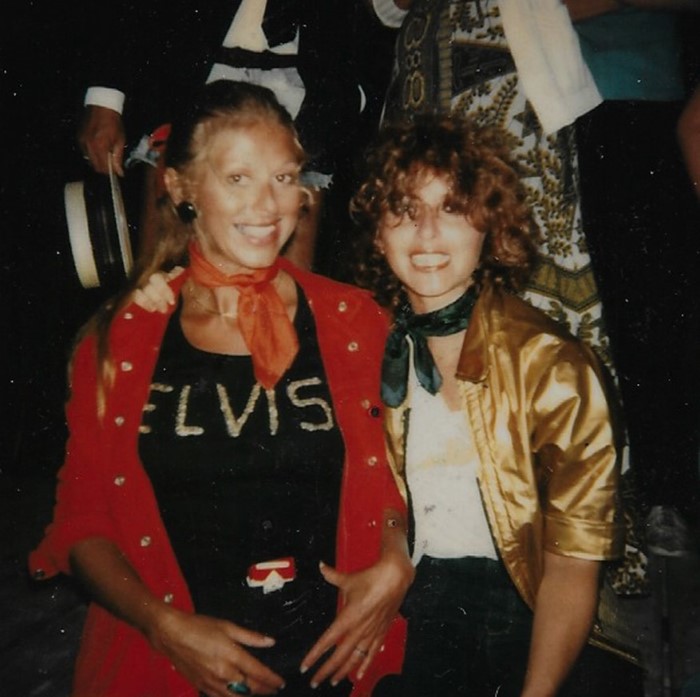
With Susan in our younger years at a ’50s party
When her cancer returned, her other friends unaware because, as is often the case, she kept this news secret. In March 1988 Susan reached her breaking point and it was her therapist, the late Dr. Sukie Miller, who convinced her to get her friends to her office the very next night so we might find a way to help.
Susan called 15 friends and 12 of us showed up. We didn’t know each other but we had such a powerful experience that night—buckets of tears were shed—that it galvanized us to action. The urgency and love we felt propelled us into what was to develop into a group caregiving model that has helped people all around the world for over 22 years.
Over the next three and a half years, we did everything imaginable for Susan. Our proudest moment came when we organized her youngest daughter’s wedding just four months before Susan died in 1991. By then, our little group of strangers turned sisters was widely known as “Susan’s Funny Family.”
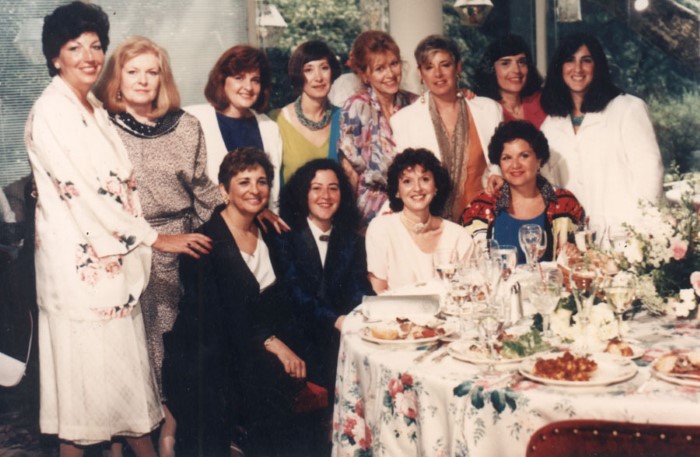
Susan’s Funny Family at the wedding we organized (Susan is sitting at the table in pale pink)
Then our group was asked to help another woman in similar circumstances organize her friends into a “funny family.” It was while teaching the plan—a way of working and sharing responsibilities—that I witnessed their transformation from fearful and uncertain to empowered and eager to begin. It was then that I realized how profoundly I had been impacted by my experiences as a solo caregiver vs. being part of a group. It was like being struck by a lightning bolt.
This inspired me to call “funny family” member and friend Cappy Capossela the next morning to say we need to put this work down on paper so that others can follow in our footsteps. Share The Care: How to Organize a Group to Care for Someone Who Is Seriously Ill by Sheila Warnock and the late Cappy Capossela was published in 1995 by Simon & Schuster Fireside Books.
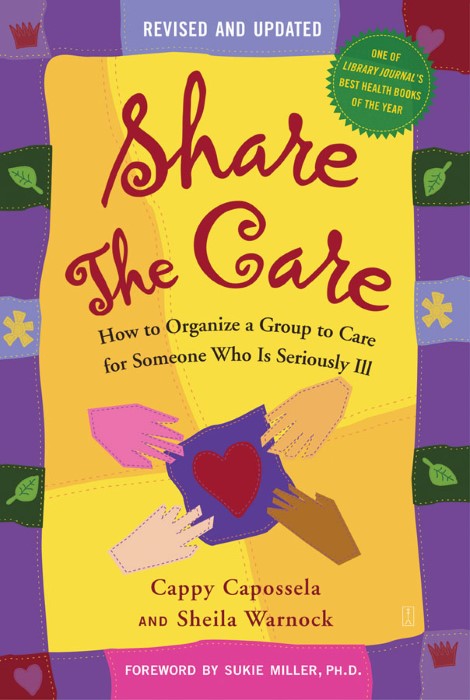
Did the book inspire your next act?
No, the event that inspired my next act was destined to happen seven years after Share the Care was published.
During the time my mother was in a nursing home and I was part of Susan’s Funny Family, I went back into advertising to make my living and I started working with Cappy on the development of names and concepts (TV and print) for men and women’s fragrances. In other words, we were in the business of selling romance.
The small amount of money Cappy and I had earned from our book was put toward publicizing it. Share The Care was a first of its kind. It was featured in newspapers and magazines like The Washington Post, Good Housekeeping, and Redbook. Cappy and I also started getting thank you calls, letters, and cards from all around the country. We were thrilled that the book was doing its job. In 2000, we were honored to be invited to write an article for Bill Moyer’s On Our Own Terms website. I included an email address and before I knew it, I was getting inquiries from all over the US and I spent several hours after work responding to each of them. I felt like the “Dear Abby” of caregiving.
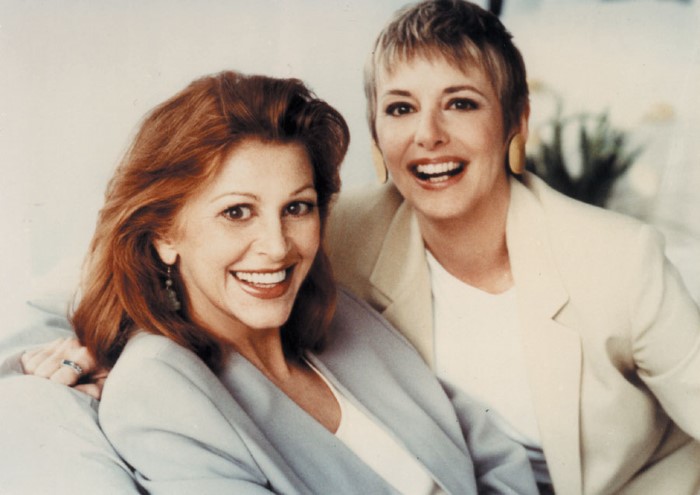
With my co-author, Cappy (Photo credit: Ken Nahoum)
Then in early 2002, the unthinkable happened: Cappy’s dad was diagnosed with a malignant brain tumor and, two weeks later, Cappy was in the hospital with the same diagnosis. I was stunned. I couldn’t believe it. They had both always been in great health. While the family took on the care of her dad, I organized a meeting of 33 of Cappy’s friends in her New York City apartment. Some even came in from as far as California, Texas, and Arkansas to help out. We were dubbed “Cappy’s Brain Trust.”
Cappy decided on surgery to debulk her tumor. Unfortunately, she lost her speech, her ability to write, then to walk, and later to move her body. Alternative treatments failed and everyone (including health professionals) struggled to keep her life in order with such a lightning fast illness. Ten months later, she and her dad passed away within 12 hours of each other.
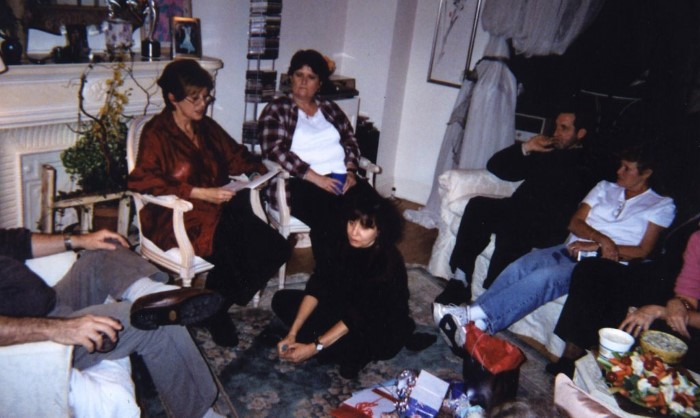
Cappy’s Brain Trust
Afterwards, I remember telling two “Brain Trust” friends that I was going to start a non-profit organization to get Share The Care out to a much wider audience. They looked at one another and one of them said, “You know, I think she is really going to make it happen!”
I had not only lost my best friend, but also an amazing creative partner and co-author. This was the dramatic turning point that propelled me fully into my life’s work and gifting me with my real purpose. Everything that I have ever done or learned in life was to be put to use in my next act.

What is your next act?
I am the Founder and President of ShareTheCaregiving, Inc. (aka Share The Care™) the nonprofit I launched in early 2003, at the age of 60. Our mission is to improve the quality of life for anyone who needs support and to reduce the stress, depression, isolation, and economic hardship of their caregivers.
Our organization offers education—presentations, keynotes, workshops for all kinds of audiences, professional and faith-based trainings—along with email and telephone support. All 23 forms in the Share The Care book can be downloaded and printed from the website along with other materials. The website features four sections so our target audiences can find what they need: Caregivers and Concerned Friends; Health Professionals; Faith Communities; and Corporations.
The Share The Care™ model has become increasingly more relevant as we move closer to 2030, when the “the caregiving crisis” is projected to hit. By then our aging Boomer population will have reached 65+ and doubled in size to 71 million people. Many will need care. The problem is that there will not be enough health professionals to care for everyone, nor will there be enough younger people who might take on that role. This issue is global in scope.
We believe we can all be part of the solution by moving towards a place where helping each other through medical, health, or aging challenges is part of life not just something we may or may not do on occasion.
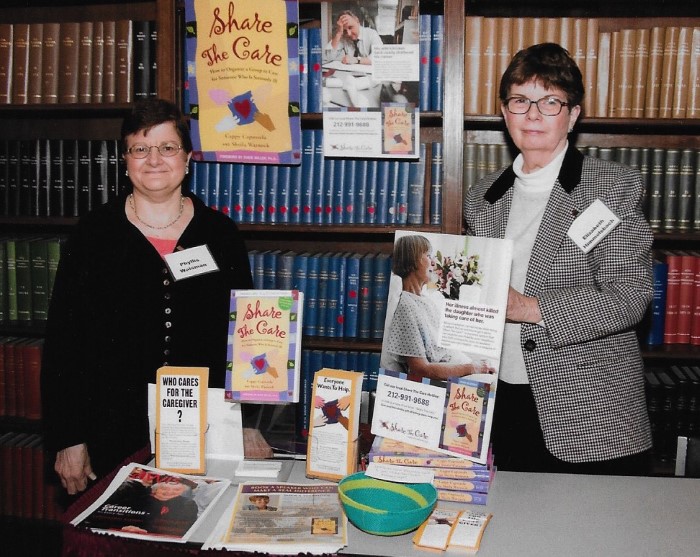
Two of our wonderful volunteers at a caregiver conference (Phyllis Waisman and Betty Himmelsbach)
How hard was it to take the plunge?
Friends and family (both mine and Cappy’s) as well as board members were immensely supportive. They donated $8,000 to get the ball rolling and I set up shop in my apartment.
I knew there would be enormous amounts of work to do and things to learn. I did a lot of reading and research to prepare to apply for 501c3 non-profit status, especially since each state has their own rules and regulations regarding non-profits.
My first job was to update Share The Care for a second edition. I added 50 pages based on the work Cappy’s group did to cope with her very demanding illness as well as my informal research of Share The Care groups around the country. The second edition was cited by The Library Journal as “One of the Best Health Consumer Books of 2004.” It also won a Caregiver Friendly Award for “Best Book” from Today’s Caregiver magazine in 2008.
I was fortunate to meet two women who had started non-profit organizations to help caregivers about the same time as the first edition of Share The Care was published. Suzanne Mintz was very encouraging. She was the Co-Founder of the National Family Caregiver’s Association, that would become the Caregiver Action Network. And Gail Mitchell, President of the National Organization for Empowering Caregivers was very helpful and introduced me to a talented website designer, Sharon Cooper of Creative Art Link. Sharon and I started working together to create a comprehensive website that we totally overhauled in 2015. It won an award that year for “Best Media” from Today’s Caregiver Magazine.
Early on, I was also blessed to have three Share The Care Volunteer Outreach Directors. Fay Radding, MA, RN (NY), Claire Culbertson, MPH (WI), Susan Poor, MPH (CA), and I got together to meet and to discuss strategies. However, the highlight of our weekend together was a dinner with the (late) Florence Wald, known as the “mother of the American hospice movement.” I gave her a copy of Share The Care and she was very encouraging. To meet her was a true inspiration for the four of us.
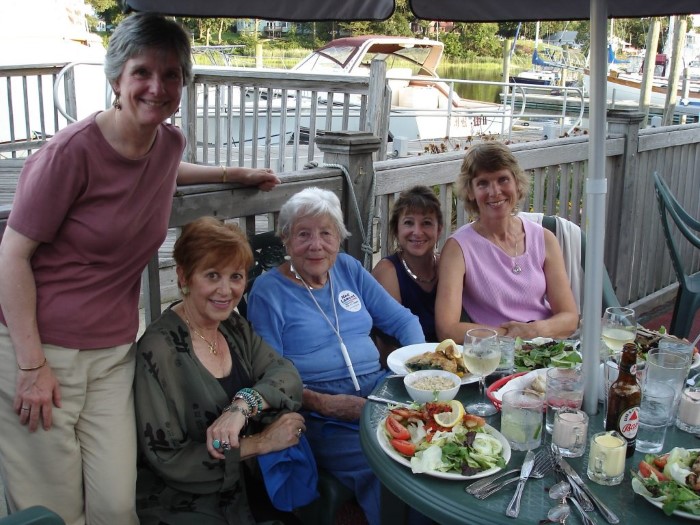
Outreach Directors Weekend (Susan Poor, me, the late Florence Wald, Fay Radding, and Claire Culbertson)
What challenges did you encounter?
There were three that stand out.
Reaching our target audience:
When I first started out, I wanted to present Share The Care to the public. I got several venues to give me space and advertise the event, but only two or three people showed up. After a few tries, I thought back on my days as a caregiver and recalled that I never had the time or energy to do anything other than being a caregiver. So I quickly came to the conclusion that I needed to reach caregivers in another way––through the health professionals or clergy they see on a regular basis. Nurses, social workers, hospice workers, geriatric care manager, aging specialists, etc. were my new target audience.
I developed a curriculum for a full-day training so that participants could learn about the model and introduce it to caregivers and families in need of support. That way they might consider using it. The professional was to be a guide, a coach, or a cheerleader who could help to empower caregivers and their concerned friends to take charge and start their own group, following the step-by-step instructions in the book. Note: a group is organized by two friends who will prepare for a first meeting (scripted) to get things moving immediately.
Today, that training is known as Seeding Share The Care™ in Your Community and is accredited by the Northeast Multi-State Division of RN Continuing Education for 6.25 credits. I have personally trained approximately 1,600 health professionals and clergy. I have led 26 trainings in 11 states and Canada for hospitals, area agencies on aging, underserved communities (most recently the Saint Regis Mohawk Tribe), and faith communities. We also kicked off many large-scale programs, most notably two in Wisconsin state, SW Ontario, and on the Island of Kauai.
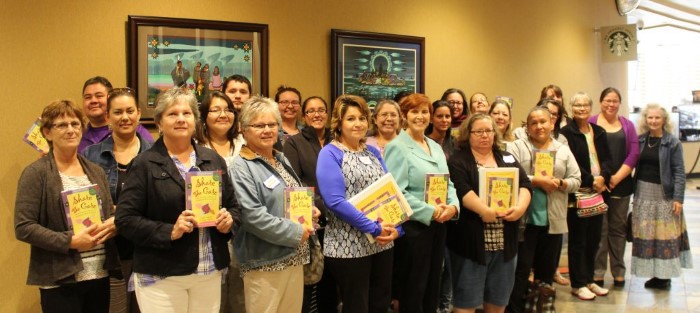
With participants my training session for the Saint Regis Mohawk tribe in Akwesane, NY
Building Credibililty:
Another challenge was to figure out a way to meet health professionals locally as I knew no one in the field. In 2004, following my very first presentation to a business committee involved with aging issues, I was directed by Elder Care Attorney, Peter Strauss, Esq. to meet the co-chair of the newly-forming New York City Family Caregiver Coalition, Greg Johnson. The minute I presented him with the book, he got it. He was a stroke survivor and had been helped through that time by his circle of friends. It was on a positive note that I joined the coalition and began earning the respect of many wonderful health professionals, government and non-profit leaders, and authors who were engaged in supporting caregivers in New York City. Today the coalition, renamed LiveOn NY, is focused specifically on Policy and Advocacy.
More recently, Greg founded EmblemHealth’s New York City Partnership for Family Caregiving Corps and invited Share The Care to be one of the co-chairs and founding members along with SAGE, Friends In Deed, Intersections International, Spiritual Conditioning for Family Caregivers. The goal is to get the message to corporations and organizations that their bottom lines are affected negatively when their employees take on the role of caregiver alone. The Corps provides an array of services and information to address the many faces of caregiving.
I highly recommend joining any organization, union, corps or group that is working in the field you want to transition into.
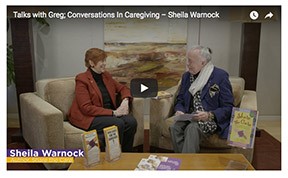
With Greg Johnson: See Talks with Greg Johnson on YouTube
Evidence and Validation:
Share The Care was a grassroots model that was born out of personal experience. One thing we needed was some research to prove how effective we had been. A Share The Care Study entitled “The Role of Unpaid Volunteers in a Group Caregiving Approach: Validation of the Share The Care Program” by Amy Hegener, PhD was published in the 2016 Journal of Gerontological Social Work. (Full copy of the article is available upon request from Share The Care.)
The study included 134 people–care recipients, family caregivers and individual group members from the US, Canada, Australia, The UK, and Hong Kong. The findings provide a foundation of supportive evidence that confirms Share The Care as a best-practice model in the field of caregiving and one that can be replicated in a cost effective manner across locations and challenges. Specifically, Share The Care: 1) supports a care receiver’s ability to stay at home with necessary informal systems in place; 2) Increases the caregiving preparedness of group members, enabling them to be more effective teammates and future caregivers; 3) is replicable and its functionality can be applied across a variety of settings and circumstances; 4) ensures longevity and a successful caregiving experience through its structured system of care; 5) helps reduce the burden of the caregiver; and 6) has a positive impact on the well-being of the caregiver, care receiver, and group members.
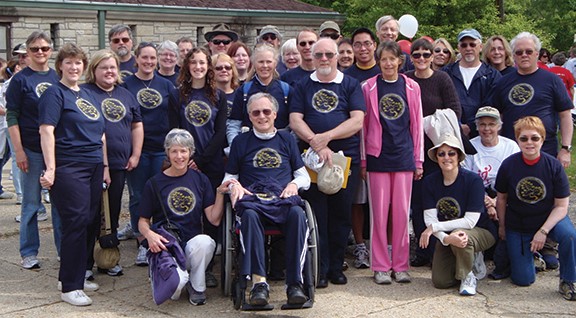
Bob’s Brigade in Wisconsin
What did you learn about yourself by overcoming these challenges?
I found that I had enormous focus and staying power to do whatever I needed to do on the path toward success. You don’t just arrive at success, but rather find yourself on a journey that turns out to be infinitely more valuable than any destination.
I discovered that my experiences had turned into my PASSION for helping caregivers and was the fuel that drove me. Maybe Share The Care was not the career I had imagined for myself, but one for which I was splendidly suited.
I learned as I kept putting in the time and effort working towards building my speaking and teaching opportunities, I grew more and more comfortable in my new role. I also started to be a really good networker, something I had avoided in advertising.
My philosophy has been if something doesn’t work out, there will be something else that might be a better fit or opportunity just down the line.
Looking back, is there anything you’d have done differently?
Not too much. I refuse to spend my life whining “I coulda, woulda, shoulda.” I tried to never get bogged down by people telling me I couldn’t do something. I did take seriously people who kindly took the time to give me guidance and suggestions. Then, based on my own gut, I decided to take it or not.
What advice do you have for women seeking reinvention in midlife?
Only YOU know in your soul when something is totally right for you—or wrong for you. For your next act, go for whatever gives you the greatest joy and fulfillment.
Take care of yourself. Get out of any bad circumstance (job, marriage, relationship, habits, or location) that harms your self-esteem, your health, or your sense of hope. Stay healthy so you can keep working as long as you like.
Mindful living/thinking. Don’t just react, but rather observe how you deal with situations or people in an effort to improve on what you say and do or don’t do.
Never stop learning. I believe that working/learning/curiosity are attributes that keep one sharp, young and interesting. Especially important for our fast-moving times.
Have BIG Dreams. Spend time alone to think about them.
Take Action.
There will be people who give you a helping hand on your way to where you are going. GIVE BACK and help someone who looks to you for information, encouragement, or direction.

What advice do you have for those interested in launching a non-profit?
Continually work on yourself as you work toward your new career in the non-profit world. Take courses, go to lectures, read books, and explore the web. You will need to be willing to take time away from some of your other pleasures; however, do try to find room for both. Have boundaries.
The most important questions you need to ask yourself are:
- Why am I doing this? Can I stay the course?
- Can I cope with living on the edge? Money issues are part of non-profit life, especially if just beginning or the organization is very small.
- Can I learn from my failures, make adjustments, and then keep going?
- What am I brilliant at doing? What do I still need to learn? Be aware.
Remember to prioritize and ask for help when you need it. ShareTheCaregiving only has volunteers and I often call upon the expertise of board and steering committee members to help me with a specific need. Most have, at some point, been a caregiver and are dedicated to helping other caregivers by gifting us with their time, energy, and support.
What resources do you recommend?
If you are not establishing a new non-profit, then align yourself with one that serves a cause close to your heart. In my experience, most people doing non-profit work have a personal story or experience that brought them to the place of wanting to help others.
Start with The Foundation Center, the go-to place to find everything a non-profit needs to know. Work with an attorney when processing paper work for a 501c3 or align yourself with a fiscal sponsor. The latter suggestion might be a wise way to start.
That said, I am not going to suggest new books about non-profit work but rather put emphasis on books/suggestions that serve the development of self. I believe that the work starts within each of us.
Books:
These are books that I found inspiring for being successful, no matter what your job.
Two books by Daniel Goleman define the qualities that are critical for leaders and building relationships in the 21st century: Social Intelligence: The New Science of Human Relationships and Working with Emotional Intelligence
Never Eat Alone: And Other Secrets to Success, One Relationship at a Time by Keith Ferrazzi deals with building relationships (networks, colleagues, contacts, friends, mentors)
Do Less, Achieve More: Discover the Hidden Powers Giving In by Chin-Ning Chu. I love this little book; it’s a small paperback packed full of wisdom.
The Artist’s Way by Julia Cameron is a book I got in 1993. It is an excellent workbook for people who want to discover and recover their creative self. Also check out: The Artist’s Way At Work.
The 8 Laws of Change: How to Be an Agent of Personal and Social Transformation by Stephan A. Schwartz is great for all kinds of social, personal, societal, and global transformations.
The Power of Being Yourself: A Game Plan for Success–by Putting Passion into Your Life and Work by Joe Plumeri
The Millionaire Messenger: Make a Difference and a Fortune Sharing Your Advice by Brendon Burchard, Founder of the Experts Academy.
Unlimited Power : The New Science Of Personal Achievement by Anthony Robbins
Thank You for Being Late: An Optimist’s Guide to Thriving in the Age of Accelerations by Thomas L. Friedman, an optimist’s guide to thriving in the age of acceleration
Reboot Your Life: Energize Your Career and Life by Taking a Break by Catherine Allen, Nancy Bearg, Rita Foley, and Jaye Smith

Quotes:
I have a lot of books with inspiring quotes that I read through every so often. They remind me that many have travelled the road and left us with breadcrumbs of wisdom.
The heights by great (wo)men reached and kept
Were not attained by sudden flight
But, they while their companions slept,
Were toiling upward in the night.
–Henry Wadsworth Longfellow
I always knew that one day
I would take this Road but
Yesterday
I did not know today
would be the day.
–Nagarjuna
The meeting of preparation with opportunity generate the offspring we call luck.
— Anthony Robbins
What lies behind us and what lies before us
are tiny matters, compared to what lies within us.
–Ralph Waldo Emerson
In the middle of difficulty lies opportunity.
–Albert Einstein
Life is a gift you are only given once. Strive to make the best use of it.
–Anon
And the trouble is, if you don’t risk anything, then you risk even more.
–Erica Jong
All of us are stars and deserve the right to twinkle.
–Marilyn Monroe
You must be the change you wish to see in the world.
–Mahatma Gandhi
It’s OK to have butterflies in your stomach. Just get them to fly in formation.
–Helen Keller
It is never too late to be what you might have been.
–George Eliot
Whatever you can do or dream you can, begin it.
Boldness has genius, power and magic in it.
–Goethe
The man who moved a mountain is the one who started taking away the small stones.
–Old Chinese Proverb
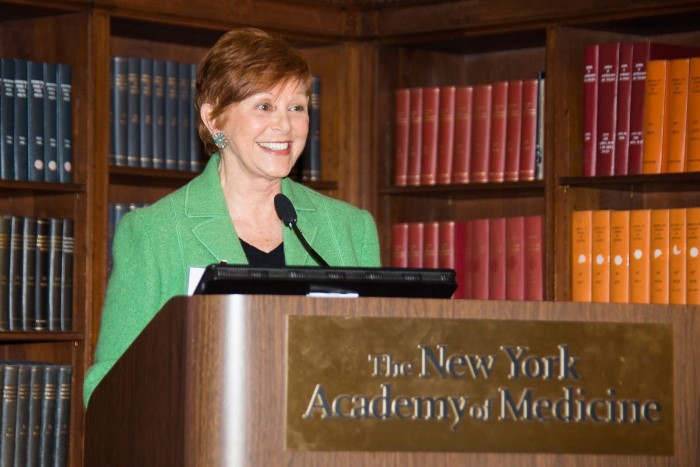
Speaking at a large Emblem Health Caregiver Conference
What’s next for you?
My current act has plenty of room for evolving. My goal is to be offered many more opportunities to speak at conferences and lead Share The Care™ trainings nationally and internationally. We want to work with other organizations to get the public prepared for the global caregiving crisis.
Just a few things I’d love to see for Share The Care:
- be published in Spanish and French
- become part of the curriculum for students of social work and nursing
- offer online courses
- be integrated into all Patient Centered Care
- become a household word
Personally, I have been told that just speaking about my life journey could prove to be of great interest to young people.
Connect with Sheila Warnock
Founder and President, Share The Caregiving, Inc.
Email: swarnock@sharethecare.org
Website
Facebook Page
Twitter
LinkedIn
Book: Share The Care: How to Organize a Group to Care for Someone Who Is Seriously Ill
Contact Sheila for inquiries regarding trainings, workshops, and presentations.
Information, stories, excerpts, resources, links to purchase the book, testimonials, and all 23 forms from the book are available on the website.
Share The Care is recommended reading and cited by other authors, including Gail Sheehy and Daniel Golman, and listed as a resource in numerous caregiving books, websites, and articles.
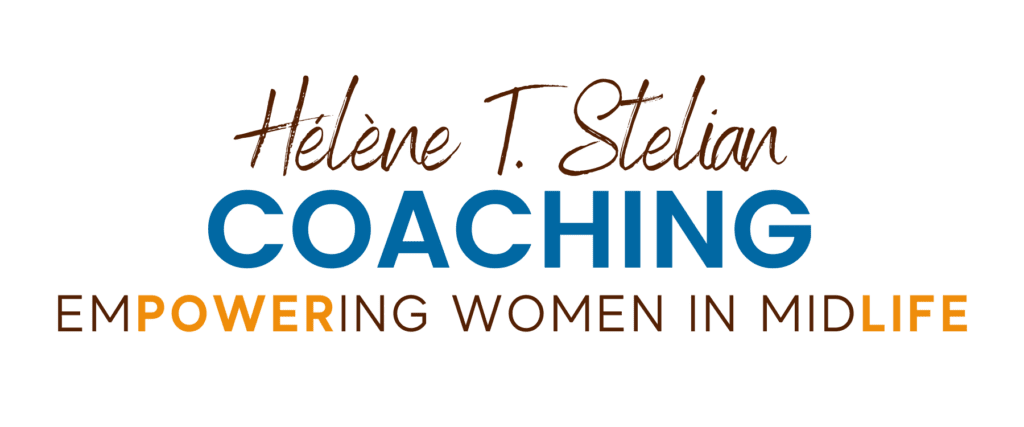

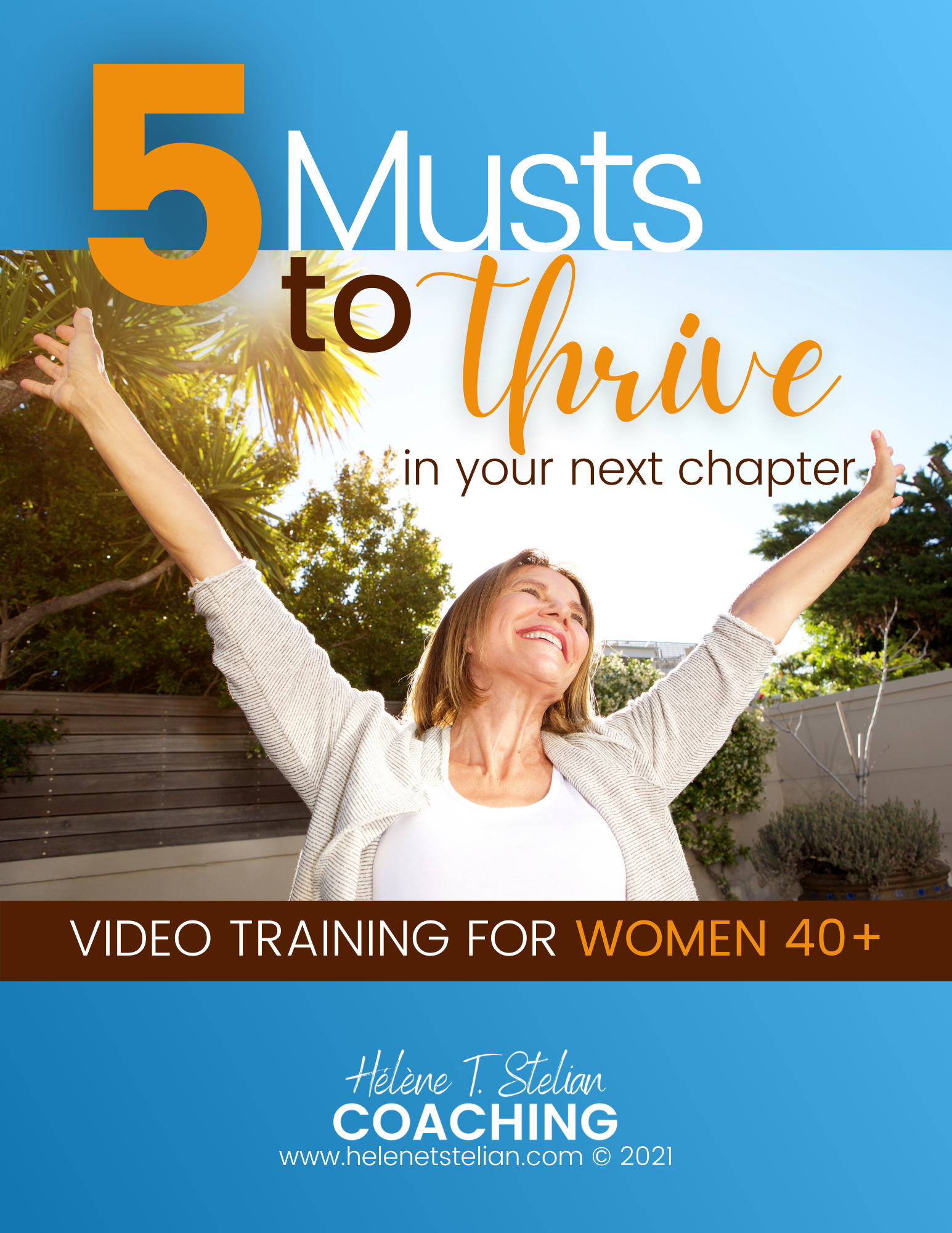


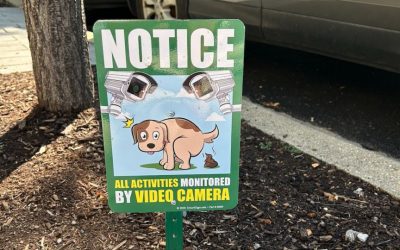
0 Comments